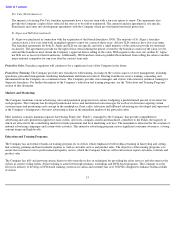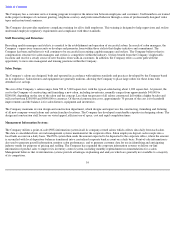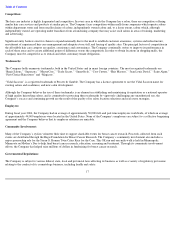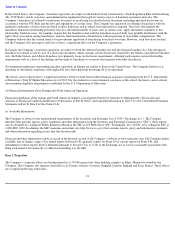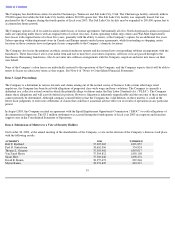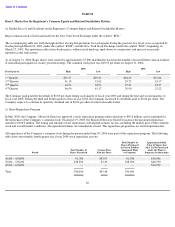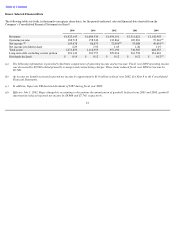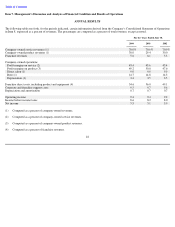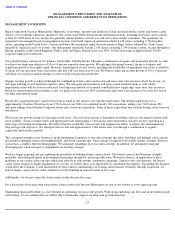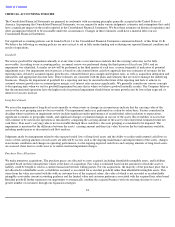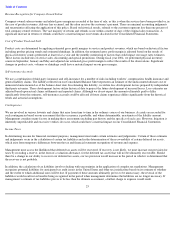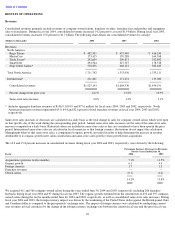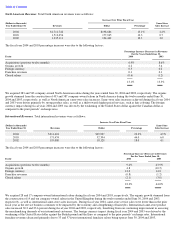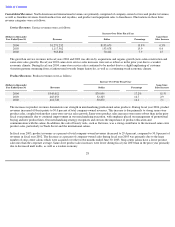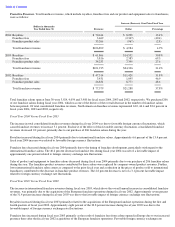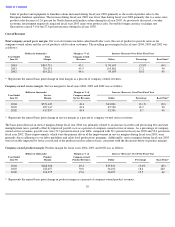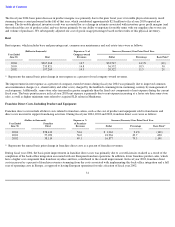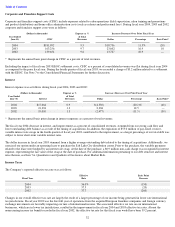Supercuts 2004 Annual Report Download - page 31
Download and view the complete annual report
Please find page 31 of the 2004 Supercuts annual report below. You can navigate through the pages in the report by either clicking on the pages listed below, or by using the keyword search tool below to find specific information within the annual report.
Table of Contents
Revenue Recognition for Company
-Owned Salons
Company-
owned salon revenues and related gross margin are recorded at the time of sale, as this is when the services have been provided or, in
the case of product revenues, delivery has occurred, and the salon receives the customer’s payment. There are minimal accounting judgments
and uncertainties affecting the application of this policy. Based on historical results, refunds to the customer represent less than one percent of
total company-owned revenues. The vast majority of returns and refunds occur within a matter of days of the original sales transaction. A
significant increase in returns or refunds could have a material impact on revenues disclosed in the Consolidated Financial Statements.
Cost of Product Used and Sold
Product costs are determined by applying estimated gross profit margins to service and product revenues, which are based on historical factors
including product pricing trends and estimated shrinkage. In addition, the estimated gross profit margin is adjusted based on the results of
physical inventory counts performed at least twice a year and the monthly monitoring of factors that could impact our usage rates estimates.
These factors include mix of service sales, discounting and special promotions. During fiscal year 2004, we performed physical inventory
counts in September, January and May and adjusted our estimated gross profit margin to reflect the results of the observations. Significant
changes in product costs, volumes or shrinkage could have a material impact on our gross margin.
Self-insurance Accruals
We use a combination of third-party insurance and self-insurance for a number of risks including workers’ compensation, health insurance and
general liability claims. The liability reflected on our Consolidated Balance Sheet represents an estimate of the undiscounted ultimate cost of
uninsured claims incurred as of the balance sheet date. In estimating this liability, we utilize loss development factors prepared by independent
third-party actuaries. These development factors utilize historical data to project the future development of incurred losses. Loss estimates are
adjusted based upon actual claims settlements and reported claims. Although we do not expect the amounts ultimately paid to differ
significantly from the estimates, self-insurance accruals could be affected if future claims experience differs significantly from the historical
trends and actuarial assumptions.
Contingencies
We are involved in various lawsuits and claims that arise from time to time in the ordinary course of our business. Accruals are recorded for
such contingencies based on our assessment that the occurrence is probable, and where determinable, an estimate of the liability amount.
Management considers many factors in making these assessments including past history and the specifics of each case. However, litigation is
inherently unpredictable and excessive verdicts do occur, which could have a material impact on our Consolidated Financial Statements.
Income Taxes
In determining income for financial statement purposes, management must make certain estimates and judgements. Certain of these estimates
and judgements occur in the calculation of certain tax liabilities and in the determination of the recoverability of certain deferred tax assets,
which arise from temporary differences between the tax and financial statement recognition of revenue and expense.
Management must assess the likelihood that deferred tax assets will be recovered. If recovery is not likely, we must increase our provision for
taxes by recording a reserve, in the form of a valuation allowance, for the deferred tax assets that will not be ultimately recoverable. Should
there be a change in our ability to recover our deferred tax assets, our tax provision would increase in the period in which it is determined that
the recovery is not probable.
In addition, the calculation of tax liabilities involves dealing with uncertainties in the application of complex tax regulations. Management
recognizes potential liabilities for anticipated tax audit issues in the United States and other tax jurisdictions based on its estimate of whether
and the extent to which additional taxes will be due. If payment of these amounts ultimately proves to be unnecessary, the reversal of the
liabilities would result in tax benefits being recognized in the period when management determines the liabilities are no longer necessary. If
management’s estimate of tax liabilities proves to be less than the ultimate assessment, a further charge to expense would result.
25


